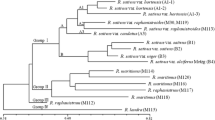Abstract
The genetic variation of 102 natural populations of wild barley growing in Spain was assessed using RAPDs (random amplified polymorphic DNA). The plant material included the annual species H. marinum subsp. marinum (22 populations) and subsp. gussoneanum (14), H. murinum subsp. murinum (7) and subsp. leporinum (35), and the perennial species H. bulbosum (17) and H. secalinum (7). Ten of the tested 64 arbitrary 10-mer primers amplified polymorphic DNA in all taxonomic units. Analyses was performed within and between populations, species and subspecies. The primers gave a total of 250 RAPD products. The level of polymorphism varied between taxonomic units depending on the primers employed and the plant reproductive system. In general, the most variable were the allogamous species H. secalinum and H. bulbosum and the autogamous H. marinum subsp. marinum. Among the amplified bands, 69 (27%) were shared by at least two different taxonomic units. The remaining bands were specific. The results demonstrate differences in the degree of similarity between taxonomic units. Jaccard’s similarity coefficients for interval measure within and between populations were used to produce a cluster diagram using the unweighted pair-group method (UPGMA). The different populations of the species and subspecies of Hordeum fell into three groups. The first group contained the populations belonging to both subspecies of H. marinum, plus those of H. secalinum. The populations of H. marinum subsp. gussoneanum were very closely associated. Those of H. marinum subsp. marinum were grouped in a broad cluster. The second group, occupying the innermost position of the tree, was very closely associated with the populations of both subspecies of H. murinum. The third branch segregated H. bulbosum. A series of RAPD markers were investigated by cleaving the amplified products of the same size with restriction endonucleases that recognize targets of 4- or 6-bp. The production of equivalent fragments following cleavage by the same enzyme would seem to demonstrate their homology in samples from different individuals, populations or taxonomic units.
Similar content being viewed by others
Author information
Authors and Affiliations
Additional information
Received: 18 May 1997 / Accepted: 22 August 1997
Rights and permissions
About this article
Cite this article
De Bustos, A., Casanova, C., Soler, C. et al. RAPD variation in wild populations of four species of the genus Hordeum (Poaceae). Theor Appl Genet 96, 101–111 (1998). https://doi.org/10.1007/s001220050715
Issue Date:
DOI: https://doi.org/10.1007/s001220050715




